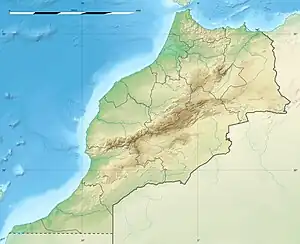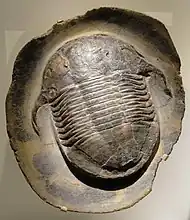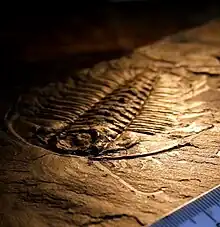| Fezouata Formation | |
|---|---|
| Stratigraphic range: [1] | |
 Fossil of a marrellomorph from one of the exceptionally preserved intervals. | |
| Type | Geological formation |
| Underlies | Zini Formation |
| Thickness | >1,000 m (3,300 ft), combined for upper and lower formations, the two exceptionally preserved intervals ~25 m (82 ft) and 15 m (49 ft) respectively |
| Lithology | |
| Primary | Shale |
| Location | |
| Coordinates | 30°36′N 5°42′W / 30.6°N 5.7°W |
| Approximate paleocoordinates | 73°54′S 108°06′E / 73.9°S 108.1°E |
| Region | Drâa-Tafilalet |
| Country | |
 Fezouata Formation (Morocco) | |
The Fezouata Formation or Fezouata Shale is a geological formation in Morocco which dates to the Early Ordovician.[2][3][4][5] It was deposited in a marine environment, and is known for its exceptionally preserved fossils, filling an important preservational window beyond the earlier and more common Cambrian Burgess shale-type deposits.[6]
Biota
Over 1,500 non-mineralized specimens, representing 50 distinct taxa that have a composition similar to earlier Burgess Shale type biotas, have been recovered from the formations in addition to a less abundant shelly fauna.[6] The make-up of the community varies significantly through the stratigraphic sequence, with both abundances and faunal composition changing as time progresses.[6] Major burrowing is not present, but there are small (1-3 mm wide) burrows in the sediment, which may indicate that there is not enough oxygen in the water or sediment.[6] Particularly notable is the presence of bryozoa and graptolites,[6] forms that are absent in the Cambrian period. Diverse echinoderms indicate a normal range of salinity, and the overall shelly assemblage is not significantly different from the normal shelly fauna expected in open Ordovician waters.[6] The non-mineralized cohort contains a range of forms familiar from the Burgess Shale: Demosponges,[7] lobopods, barnacles, annelids, radiodonts (e.g. Aegirocassis),[8] possible halkieriids, marrellomorphs, paleoscolecid worms, nektaspids, skaniids as well as the expected problematica. Other Ordovician oddballs are also present, including mitrates,[9] machaeridians,[10] cheloniellids and xiphosurans in abundance.[6]
Depositional setting

The fossiliferous strata were deposited just above storm wave base (offshore to lower shoreface transition), at between 50 and 150 metres (160 and 490 ft) water depth. Organisms were likely buried in situ.[11] Because of its placement above storm wave base, storms would have mobilized sediment that could be quickly deposited, trapping animals and leading to their preservation.[6][12] Consequently, the assemblage is dominated by benthic organisms.[6]
Preservation
Fossils of the Fezouata Formation, which are usually squashed flat (although some do retain some degree of their original three-dimensionality) are often coated with a dusting of pyrite, and tin; this aspect of the fossil preservation is very similar to that at Chengjiang.[6] Non-mineralized appendages are often preserved.[6] While the formation as a whole is over 1,000 metres (3,300 ft) thick, only two intervals, 25 metres (82 ft) and 15 metres (49 ft) thick, provide exceptional preservation.[13][14] Both of these intervals are located near the top of the lower formation, corresponding to the Araneograptus murrayi and Hunnegraptus copiosus graptolite zones respectively.[11]
Location and stratigraphy
The fossils occur within an area of 500 square kilometres (190 sq mi), in southeast Morocco's Draa Valley, north of Zagora. Stratigraphically productive layers are found through a 1.1 kilometres (0.68 mi)-thick column of rock that spans the Tremadocian and Floian epochs.[6] Two stratigraphic intervals of the formation are fossiliferous: the lower is Late Tremadocian and sits 260 to 330 metres (850 to 1,080 ft) above the base of the formation; the upper, at 570 to 620 metres (1,870 to 2,030 ft), is mid-Floian in age.[1]
History
The Lagerstätten were first identified in the late 1990s when a local fossil collector, Ben Moula, showed some of the finds to a PhD student who was then working in the area.[15][16]
IUGS geological heritage site
In respect of the 'exceptional fossil preservation bridging the Cambrian Explosion and the Great Ordovician Biodiversification', the International Union of Geological Sciences (IUGS) included the 'Ordovician Fezouata Shale Fossil Site at Jbeltizagzaouine' in its assemblage of 100 'geological heritage sites' around the world in a listing published in October 2022. The organisation defines an IUGS Geological Heritage Site as 'a key place with geological elements and/or processes of international scientific relevance, used as a reference, and/or with a substantial contribution to the development of geological sciences through history.'[17]
Paleobiota
After[18] and subsequent literature:
Arthropods
| Arthropods | |||
|---|---|---|---|
| Genus | Notes | Images | |
| "Furca" | A marrelid marrellomorph. Not formally described. The name "Furca mauretanica" is a nomen nudum. Possibly multiple species present |  | |
| Enosiaspis | A acercostracan marrellomorph |  | |
| Aegirocassis | A giant filter-feeding hurdiid radiodont |  | |
| Pseudoangustidontus | A filter-feeding hurdiid radiodont |  | |
| Thelxiope | A mollisoniid, possibly related to chelicerates. |  | |
| Eoduslia | A chelioniellid[19] | ||
| Tariccoia | A liwiid nektaspid |  | |
| Tremaglaspis | An aglaspidid | ||
| Brachyaglaspis[20] | |||
| "Synziphosurine" | Undescribed | ||
| Xiphosura | |||
| Eurypterida | |||
| Asaphellus | Trilobites belonging to the order Asaphida |  | |
| Basilicus |  | ||
| Kierarges | |||
| Platypeltoides |  | ||
| Symphysurus | |||
| Apatokephalus | |||
| Dikelokephalina |  | ||
| Orometopus | |||
| Cnemidopyge | .jpg.webp) | ||
| Lichakephalus | A trilobite belonging to Lichida | ||
| Parvilichas | |||
| Selenopeltis | A trilobite belonging to Odontopleurida |  | |
| Harpides | A trilobite belonging to Harpetida |  | |
| Foulonia | trilobites belonging to Phacopida | ||
| Lehua | |||
| Parapilekia | |||
| Toletanaspis | |||
| Bathycheilus | |||
| Bavarilla | |||
| Colpocoryphe |  | ||
| Pharostomina | |||
| Prionocheilus | |||
| Agerina | A trilobite belonging to Corynexochida | ||
| Euloma | A trilobite belonging to Olenida | ||
| Geragnostus | An artiopodan arthropod (possibly a trilobite) belonging to Agnostida |  | |
Echinoderms
| Conodonts | |||
|---|---|---|---|
| Genus | Notes | Images | |
| Villebrunaster[21] | A somasteroid, originally described as Cantabrigiaster |  | |
| Aristocystites | A diploporitian | ||
| Balantiocystis | A eocrinoid | ||
| Macrocystella | A rhombiferan | ||
| Palaeosphaeronites | A cystoid | ||
| Plasiacystis | A solutan | ||
| Rhopalocystis | A eocrinoid | ||
| Ramseyocrinus | A disparid crinoid | ||
| Argodiscus | A edrioasteroid | ||
| Anedriophus | |||
| Anatifopsis | A mitrate | ||
| Chauvelicystis | A member of Cornuta | ||
| Phyllocystis | |||
| Thoralicystis | |||
| Peltocystis | A mitrate | ||
Molluscs
| Molluscs | |||
|---|---|---|---|
| Genus | Notes | Images | |
| Calvapilosa[22] | A halkeriid-like mollusc with only one shell rather than two | ||
| Pelecyogyra[23] | A onychochilid mollusc | ||
| Thoralispira[24] | A gastropod belonging to Bellerophontoidea | ||
| Carcassonnella[24] | A monoplacophoran | ||
| Sinuites[24] | A gastropod belonging to Bellerophontoidea | ||
| Lesueurilla[24] | A gastropod belonging to Lesueurillidae | ||
| Bathmoceras[25] | A "nautioid" cephalopod belonging to Ellesmerocerida | ||
| Rioceras[25] | A "nautioid" cephalopod | ||
| Destombesiceras[25] | A "nautioid" cephalopod belonging to Discosorida | ||
| Bactroceras[25] | A "nautioid" cephalopod | ||
| Polymeres[25] | A "nautioid" cephalopod belonging to Dissidocerida | ||
| Protocyptendoceras[25] | A "nautioid" cephalopod belonging to Endocerida | ||
| Alococoncha? | A bivalve[26] | ||
| Babinka | |||
| Cardiolaria? | |||
| Coxiconchia | |||
| Ekaterodonta | |||
| Glyptarca | |||
| Cienagomya? | |||
| Praenucula? | |||
| Redonia | |||
Conodonts
| Conodonts | |||
|---|---|---|---|
| Genus | Notes | Images | |
| Parapaltodus[27] | |||
| Semiacontiodus[27] | |||
| Scolopodus[27] | |||
| Scalpellodus[27] | |||
| Drepanoistodus[27] | |||
| Acodus[27] | |||
| Paltodus[27] | |||
| Cornuodus[27] | |||
| Prioniodus[27] | |||
Other animals
| Other animals | |||
|---|---|---|---|
| Genus | Notes | Images | |
| Plumulites | A machaeridian annelid | ||
| Rhabdinopora[28] | graptolites | ||
| Choristograptus[28] | |||
| Ancoragraptus[28] | |||
| Araneograptus[28] | |||
| Paratemnograptus[28] | |||
| Paradelograptus[28] | |||
| Clonograptus[28] | |||
| Expansograptus[28] | |||
| Baltograptus[28] | |||
| “Tetragraptus”[28] | |||
| Holograptus/Schizograptus[28] | |||
| Azygograptus[28] | |||
| Pirania | A sponge | ||
| Hamptonia | |||
| Choia | |||
| Ranorthis | A orthid brachiopod | ||
| Pauxillites[29] | A hyoliith | ||
| Archaeoconularia[30] | A conulariid | ||
| Eoconularia[30] | |||
| Sphenothallus[30] | |||
| Palaeoscolex[31] | A palaeoscolecid worm | ||
| "Lobopodia" | Undescribed, multiple taxa present | ||
References
- 1 2 Lefebvre, Bertrand; Gutiérrez-Marco, Juan C; Lehnert, Oliver; Martin, Emmanuel L. O; Nowak, Hendrik; Akodad, Mustapha; El Hariri, Khadija; Servais, Thomas (2017). "Age calibration of the Lower Ordovician Fezouata Lagerstätte, Morocco". Lethaia. 51 (2): 296–311. doi:10.1111/let.12240.
- ↑ Fezouata Formation at Fossilworks.org
- ↑ Fezouata Shale at Fossilworks.org
- ↑ Lower Fezouata Formation at Fossilworks.org
- ↑ Upper Fezouata Formation at Fossilworks.org
- 1 2 3 4 5 6 7 8 9 10 11 12 Van Roy, P.; Orr, P. J.; Botting, J. P.; Muir, L. A.; Vinther, J.; Lefebvre, B.; Hariri, K. E.; Briggs, D. E. G. (2010). "Ordovician faunas of Burgess Shale type". Nature. 465 (7295): 215–8. Bibcode:2010Natur.465..215V. doi:10.1038/nature09038. PMID 20463737. S2CID 4313285.
- ↑ Botting, J. (2007). "'Cambrian' demosponges in the Ordovician of Morocco: Insights into the early evolutionary history of sponges". Geobios. 40 (6): 737–748. Bibcode:2007Geobi..40..737B. doi:10.1016/j.geobios.2007.02.006.
- ↑ Van Roy, P.; Briggs, D. E. G. (2011). "A giant Ordovician anomalocaridid". Nature. 473 (7348): 510–513. Bibcode:2011Natur.473..510V. doi:10.1038/nature09920. PMID 21614078. S2CID 205224390.
- ↑ Lefebvre, B.; Botting, J. (2007). "First report of the mitrate Peltocystis cornuta Thoral (Echinodermata, Stylophora) in the Lower Ordovician of central Anti-Atlas (Morocco)". Annales de Paléontologie. 93 (3): 183. Bibcode:2007AnPal..93..183L. doi:10.1016/j.annpal.2007.06.003.
- ↑ Vinther, J.; Van Roy, P.; Briggs, D. (2008). "Machaeridians are Palaeozoic armoured annelids". Nature. 451 (7175): 185–188. Bibcode:2008Natur.451..185V. doi:10.1038/nature06474. PMID 18185586. S2CID 4401508.
- 1 2 Martin, Emmanuel L.O.; Pittet, Bernard; Gutiérrez-Marco, Juan-Carlos; Vannier, Jean; El Hariri, Khadija; Lerosey-Aubril, Rudy; Masrour, Moussa; Nowak, Hendrik; Servais, Thomas; Vandenbroucke, Thijs R.A.; Van Roy, Peter; Vaucher, Romain; Lefebvre, Bertrand (2016). "The Lower Ordovician Fezouata Konservat-Lagerstätte from Morocco: Age, environment and evolutionary perspectives". Gondwana Research. 34: 274–283. Bibcode:2016GondR..34..274M. doi:10.1016/j.gr.2015.03.009. ISSN 1342-937X.
- ↑ Saleh, Farid; Candela, Yves; Harper, David A. T.; Polechová, Marika; Lefebvre, Bertrand; Pittet, Bernard. "Storm-Induced Community Dynamics in the Fezouata Biota (Lower Ordovician, Morocco)". (limited access to full article) geoscienceworld.org. Society for Sedimentary Geology PALAIOS, print edition: 21 December 2018, pp. 535-541 (Vol. 33, No. 12). Retrieved 1 March 2019.
- ↑ Saleh, Farid; Pittet, Bernard; Perrillat, Jean-Philippe; Lefebvre, Bertrand. "Orbital Control on Exceptional Fossil Preservation (abstract only)". geoscienctworld.org (subscription w/ free abstract). Geology (magazine published) 1 February 2019. Retrieved 1 March 2019.
- ↑ "Shifts in Earth's Orbit Increase the Chances of Spectacular Fossils". The Economist. The Economist, print edition: January 26th 2019, p. 72 (1/2-page based on article in Geology--in prior footnote--1/Feb/2019). Retrieved 1 March 2019.
- ↑ Van Roy, P; Lefebvre, B; El Hariri, K; Hafid, A (2008). Exceptionally Preserved Faunas from the Lower Ordovician of the Anti-Atlas, Morocco (PDF). First international Conference and Exhibition, Marrakech, Morocco.
- ↑ Jones, N. (2010). "Weird wonders lived past the Cambrian". Nature. doi:10.1038/news.2010.234.
- ↑ "The First 100 IUGS Geological Heritage Sites" (PDF). IUGS International Commission on Geoheritage. IUGS. Retrieved 13 November 2022.
- ↑ Van Roy, Peter; Briggs, Derek E. G.; Gaines, Robert R. (September 2015). "The Fezouata fossils of Morocco; an extraordinary record of marine life in the Early Ordovician". Journal of the Geological Society. 172 (5): 541–549. Bibcode:2015JGSoc.172..541V. doi:10.1144/jgs2015-017. ISSN 0016-7649. S2CID 129319753.
- ↑ Sumrall, Colin D.; Zamora, Samuel (2011). "Ordovician edrioasteroids from Morocco: faunal exchanges across the Rheic Ocean". Journal of Systematic Palaeontology. 9 (3): 425–454. doi:10.1080/14772019.2010.499137. ISSN 1477-2019.
- ↑ Ortega-Hernández, Javier; Van Roy, Peter; Lerosey-Aubril, Rudy (May 2016). "A new aglaspidid euarthropod with a six-segmented trunk from the Lower Ordovician Fezouata Konservat-Lagerstätte, Morocco". Geological Magazine. 153 (3): 524–536. Bibcode:2016GeoM..153..524O. doi:10.1017/S0016756815000710. ISSN 0016-7568. S2CID 130254788.
- ↑ Hunter, Aaron W.; Ortega-Hernández, Javier (January 2021). "A new somasteroid from the Fezouata Lagerstätte in Morocco and the Early Ordovician origin of Asterozoa". Biology Letters. 17 (1): 20200809. doi:10.1098/rsbl.2020.0809. ISSN 1744-9561. PMC 7876607. PMID 33465330.
- ↑ Vinther, Jakob; Parry, Luke; Briggs, Derek E. G.; Van Roy, Peter (February 2017). "Ancestral morphology of crown-group molluscs revealed by a new Ordovician stem aculiferan". Nature. 542 (7642): 471–474. Bibcode:2017Natur.542..471V. doi:10.1038/nature21055. hdl:1983/70368bb0-c2df-490a-8b45-26e7b4397596. ISSN 0028-0836. PMID 28166536. S2CID 205253410.
- ↑ Ebbestad, Jan Ove R.; Lefebvre, Bertrand (November 2015). "An unusual onychochilid mollusc from the Ordovician (Tremadocian) Fezouata Formation, Morocco". Geobios. 48 (6): 427–438. Bibcode:2015Geobi..48..427E. doi:10.1016/j.geobios.2015.09.004.
- 1 2 3 4 Ebbestad, Jan Ove R. (October 2016). "Gastropoda, Tergomya and Paragastropoda (Mollusca) from the Lower Ordovician Fezouata Formation, Morocco". Palaeogeography, Palaeoclimatology, Palaeoecology. 460: 87–96. Bibcode:2016PPP...460...87E. doi:10.1016/j.palaeo.2016.01.003.
- 1 2 3 4 5 6 Kröger, Björn; Lefebvre, Bertrand (August 2012). "Palaeogeography and palaeoecology of early Floian (Early Ordovician) cephalopods from the Upper Fezouata Formation, Anti-Atlas, Morocco". Fossil Record. 15 (2): 61–75. doi:10.1002/mmng.201200004.
- ↑ Polechová, Marika (October 2016). "The bivalve fauna from the Fezouata Formation (Lower Ordovician) of Morocco and its significance for palaeobiogeography, palaeoecology and early diversification of bivalves". Palaeogeography, Palaeoclimatology, Palaeoecology. 460: 155–169. Bibcode:2016PPP...460..155P. doi:10.1016/j.palaeo.2015.12.016.
- 1 2 3 4 5 6 7 8 9 Lehnert, Oliver; Nowak, Hendrik; Sarmiento, Graciela N.; Gutiérrez-Marco, Juan Carlos; Akodad, Mustapha; Servais, Thomas (October 2016). "Conodonts from the Lower Ordovician of Morocco — Contributions to age and faunal diversity of the Fezouata Lagerstätte and peri-Gondwana biogeography". Palaeogeography, Palaeoclimatology, Palaeoecology. 460: 50–61. Bibcode:2016PPP...460...50L. doi:10.1016/j.palaeo.2016.03.023.
- 1 2 3 4 5 6 7 8 9 10 11 12 Gutiérrez-Marco, Juan Carlos; Martin, Emmanuel L.O. (October 2016). "Biostratigraphy and palaeoecology of Lower Ordovician graptolites from the Fezouata Shale (Moroccan Anti-Atlas)". Palaeogeography, Palaeoclimatology, Palaeoecology. 460: 35–49. Bibcode:2016PPP...460...35G. doi:10.1016/j.palaeo.2016.07.026.
- ↑ Valent, Martin (2015-10-31). "Pauxillites thaddei a new lower Ordovician hyolith from Morocco" (PDF). Acta Musei Nationalis Pragae, Series B, Historia Naturalis / Sborník Národního muzea řada B, přírodní vědy: 51–54. doi:10.14446/AMNP.2015.51. ISSN 1804-6479.
- 1 2 3 Van Iten, Heyo; Muir, Lucy; Simões, Marcello G.; Leme, Juliana M.; Marques, Antonio C.; Yoder, Naomi (October 2016). "Palaeobiogeography, palaeoecology and evolution of Lower Ordovician conulariids and Sphenothallus (Medusozoa, Cnidaria), with emphasis on the Fezouata Shale of southeastern Morocco". Palaeogeography, Palaeoclimatology, Palaeoecology. 460: 170–178. Bibcode:2016PPP...460..170V. doi:10.1016/j.palaeo.2016.03.008. hdl:11449/161915.
- ↑ Martin, Emmanuel L.O.; Lerosey-Aubril, Rudy; Vannier, Jean (October 2016). "Palaeoscolecid worms from the Lower Ordovician Fezouata Lagerstätte, Morocco: Palaeoecological and palaeogeographical implications". Palaeogeography, Palaeoclimatology, Palaeoecology. 460: 130–141. Bibcode:2016PPP...460..130M. doi:10.1016/j.palaeo.2016.04.009.
